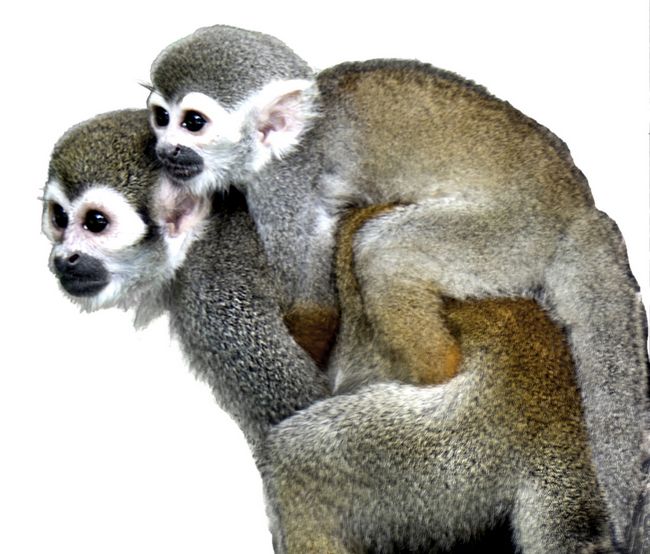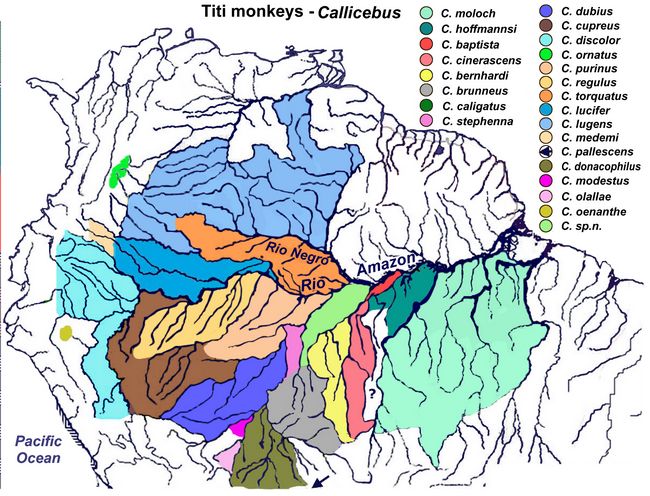Athena Review Vol. 5, no. 1
Records of Life: Fossils as Original Sources
40. New World Monkeys: modern
Spider Monkey (Ateles)
.

The spider monkey (Ateles) belongs to the Atelidae family, which also contains woolly monkeys, muriquis, and howler monkeys. Spider monkeys are widely distributed in the Amazon basin, comprising at least seven species, of which two have not yet been named. The most widespread species are A. paniscus in Venezuela, A. belzebuth in Colombian and Ecuador, A. chamek in Peru, and A. marginatus and A. mittermeieri in northern Brazil (fig.1).
Fig.1: Map of the distribution of spider monkey species in South America (after van Roosmalen 2003).

The spider monkey and other Atelidae monkeys are the only simian family to use their tails for grasping branches while climbing trees. Although they do not use tools, spider monkeys are regarded among the most intelligent primates, behind only orangutans and chimpanzees, and ahead of gorillas and all other monkeys. This mental capacity may result from the need to identify and memorize many different types of foods and their locations across large areas of forest (Byrne and Whitten 1988)
Fig.2: Geoffroy’s spider monkey (Ateles geoffroyi) in Costa Rica.
Geoffroy’s spider monkey (Ateles geoffroyi), also known as the black-handed spider monkey, is a New World Monkey (primate suborder Strepsirrhini) which lives in southern Mexico, across Central America, and possibly also in Colombia, representing at least five subspecies. Ateles geoffroyi is one of the largest New World monkeys, weighing up to 9 kg (20 lb). Its body is between 30 and 63 cm long, and tail is between 63 and 85 cm. Males and females are approximately the same size. Its arms are significantly longer than its legs, and its prehensile tail can support the entire weight of the monkey and is used as an extra limb. Its hands have only a vestigial thumb, but its long, strong, hook-like fingers allow it to swing by its arms between tree branches. The genus name Ateles means "imperfect", a reference to the vestigial thumb. The species name geoffroyi is in honor of French naturalist Étienne Geoffroy Saint-Hilaire.
Geoffroy's spider monkey lives in groupx of 20 -40 members. Its diet consists primarily of ripe fruit, comprising 70% to 80% of its food, with leaves making up most of the rest of its diet. It requires large tracts of forest to survive, with home ranges for some groups up to 900 hectares or more.
Squirrel Monkey (Saimiri)
 Saimiri,
the squirrel monkey, is a South American or New World monkey
(platyrrhini), one the two infraorders of anthropoid primates,
the other being Catyrrhini, the Old World monkeys.
Saimiri,
the squirrel monkey, is a South American or New World monkey
(platyrrhini), one the two infraorders of anthropoid primates,
the other being Catyrrhini, the Old World monkeys. The primary species, Saimiri sciureus, has four varieties which live in widespread wooded zones of river valleys throughout the Amazon basin, mainly in eastern Venezuela, French Guiana, and northern Brazil. There are also three other species of Saimiri, including Saimiri boliviensis, S. vanzoini, and S. ustus living in forested areas of Bolivia, Ecuador, and Peru.
Fig.3: Distribution of squirrel monkeys in South America (after van Roosmalen 2003)
Saimiri is among the smaller platyrrhines, with males and females less than 1 kg in weight (Fleagle, 1999). Despite its smaller size, it is closely related to Cebus, the larger capuchin monke
 y (Horovitz, 1999; Rosenberger, 2002). Saimiri eats mainly fruit, but forages for insects and other foods when on the ground (Fleagle, 1999).
y (Horovitz, 1999; Rosenberger, 2002). Saimiri eats mainly fruit, but forages for insects and other foods when on the ground (Fleagle, 1999).Guianan squirrel monkeys have a small degree of sexual dirmorphism, with males slightly larger than females. They have pink faces with black muzzles and white arches over the eyes, and olive-grey hair on the head (fig.4). Females are sexually mature at about 2 1/2 years, and males are fully mature at 4 or 5 years. Gestation period is about 5 months, and all infants within a group are typically born within one week of each other. Guianan squirrel monkeys can live more than 20 years (Boubli et al. 2008).
Fig.4: Squirrel monkeys (Saimiri sciureus) in French Guiana
The Guianan squirrel monkey's wide-ranging diet includes insects, seeds, fruit, leaves, and bird eggs. It often feeds and moves in mixed species groups with capuchin monkeys or the red-backed bearded saki.
Titi Monkey (Callicebus)

The Titi Monkey (genus Callicebus, family Cebidae) is a diurnal New World Monkey (Platyrrhini) found throughout the Amazonian rain forest. It is one of the most widespread of the Platyrrhini, with some 24 species recognized (fig.7). Callicebus has a rounded head with a short premaxilla, giving the appearance of a small, not especially prognathic face relative to other platyrrhines.
Fig.5: Callicebus moloch in Brazil.
The red bellied Titi Monkey (Callicebus moloch or Plectocebus moloch) is a diurnal New World Monkey (Platyrrhini) who inhabits the forests of Brazil (figs.6,7). It has a rounded head with a short pre
 maxilla,
giving the appearance of a small, not especially prognathic face
relative to other platyrrhines. It has a thick, soft coat, with a body
28–39 cm long, and a tail 33–49 cm long.
maxilla,
giving the appearance of a small, not especially prognathic face
relative to other platyrrhines. It has a thick, soft coat, with a body
28–39 cm long, and a tail 33–49 cm long. It lives within a fairly small area, usually in dense tropical forest close to rivers and river banks. It has a frugivorous diet, eating anything from fruits and twigs to leaves and insects. Like other Titis, they are highly territorial and send out vocal calls to mark territory and scare off other animals. They move around in daytime in pairs or family groups, which communicate by means of a wide repertoire of sounds. The female gives birth to a single offspring.
Fig.6: Map of species distribution of the Titi monkey in Amazonia (after van Roosmalen 2003)
References:
Byrne, R. and A Whiten 1988. Machiavellian intelligence: social expertise and the evolution of intellect in monkeys, apes, and humans. Oxford University Press
Boubli, J.-P., SA. B. Rylands, S. de la Torre, & P. Stevenson, P. 2008 Saimiri sciureus . IUCN Red List of Threatened Species.
Fleagle 1999
Hershkovitz, P. 1990. Titis, New World Monkeys of the Genus Callicebus (Cebidae, Platyrrhini): A Preliminary Taxonomic Review. Fieldiana Zoology. New Series. 55: 1–109.
Horovitz 1999
Rosenburger 2002
Rosenberger, A., L. Halenar, S. Cooke, and W. Hartwig 2008. Morphology and evolution of the spider monkey, genus Ateles. In Campbell, C. (ed.). Spider Monkeys. Cambridge University Press.
van Roosmalen, M. and T. van Roosmalen, 2003. Geographic distributions of Amazonian primates. http://www.amazonnewspecies.com.
Glossary